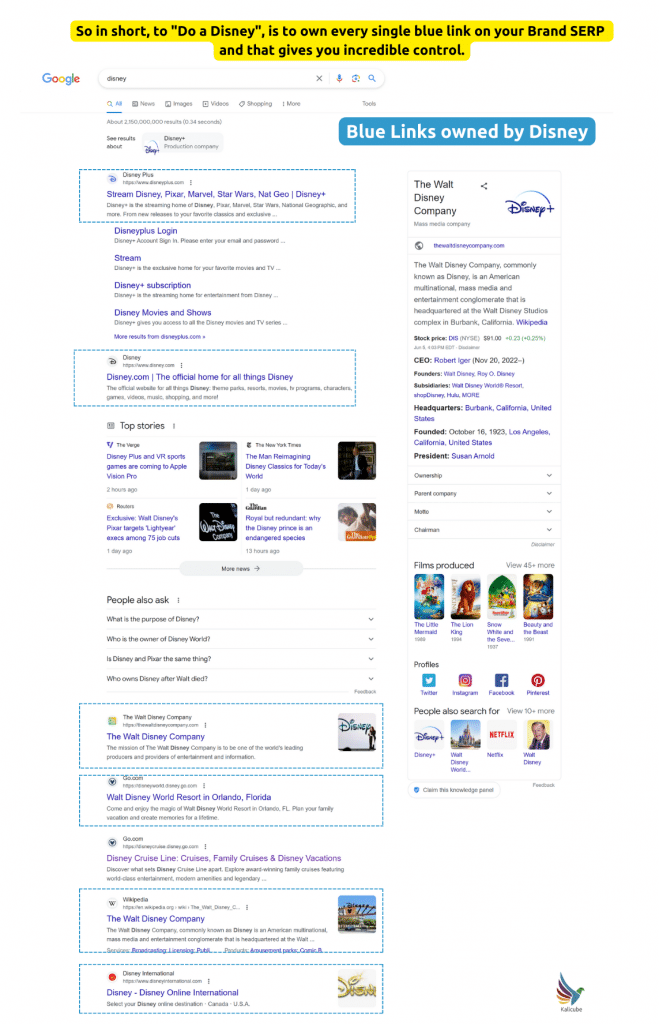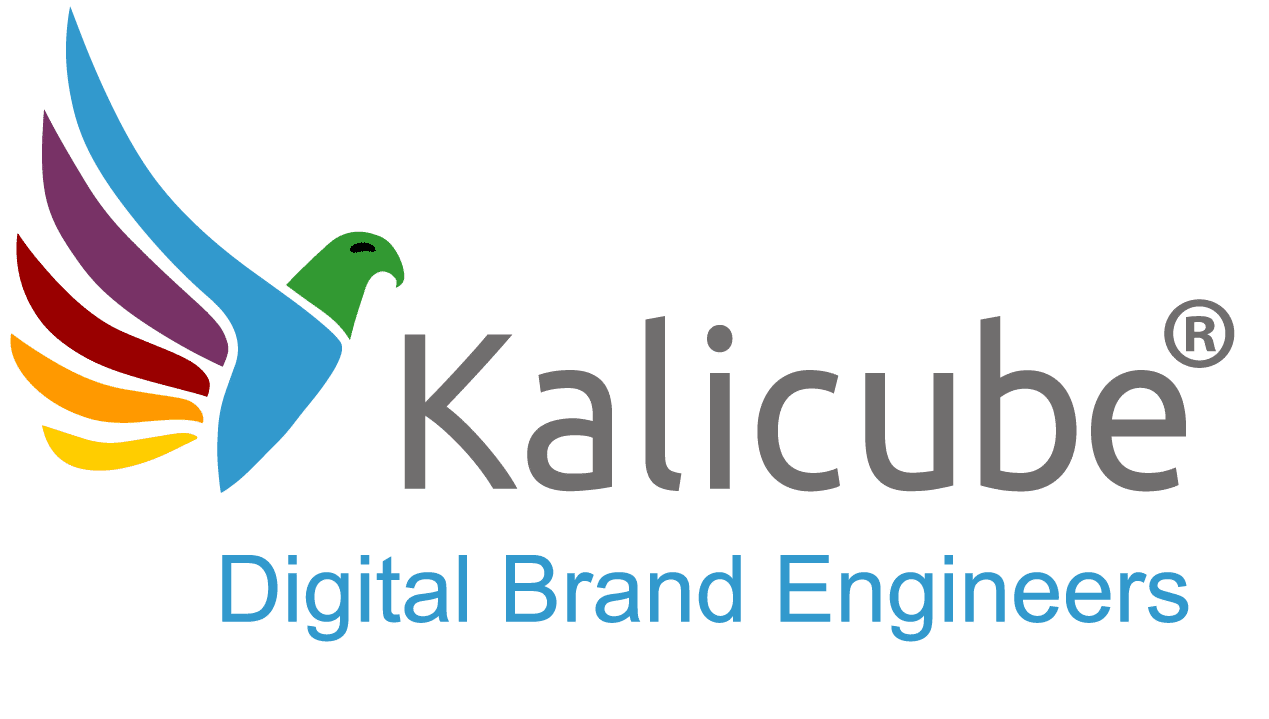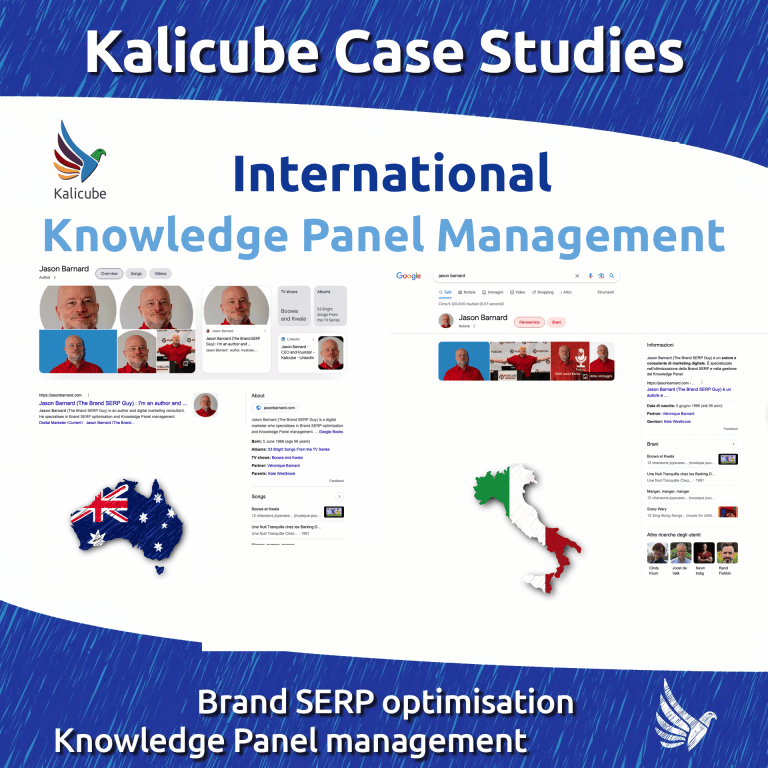“Doing a Disney” on Google: What You Need To Know

What does “Doing a Disney” mean?
“Doing a Disney” refers to a Brand SERP where a brand has complete control over all the blue links on the first page of the search engine results page (SERP). This includes blue links from different domains, all owned by the same company.
“Doing a Disney” is a term coined by Jason Barnard, the founder and CEO of Kalicube®, who is also known as The Brand SERP Guy®. The term originated from the Walt Disney Company, which was the first company to achieve this level of control over its search engine results page. The goal is to minimise unbranded content or information from other sources.

How did Disney manage to “Do a Disney” on its Brand SERP?
“Doing a Disney” holds immense value in the Brand SERP world. Disney’s mastery of their Brand SERP is evident as they exert full control over each blue link.
Their journey commences with disney.com, leading seamlessly to disneyworld.disney.go.com, disneyplus.com, and thewaltdisneycompany.com.
The essence of “Doing a Disney” is to focus exclusively on the blue links and ignore the influence of the Rich Elements. This approach emphasises that in the context of “Doing a Disney,” it is the blue links alone that truly MATTER!
Even ignoring rich elements like People Also Ask, Disney’s dominance continues unabated, as links like shopdisney.com, Twitter Boxes, Video Boxes, Image Boxes, and disneysprings.com show. Similarly, Disney’s triumphant efforts in France with domains like disneylandparis.com and disneyinternational.com illustrate the art of “Doing a Disney flawlessly.
Could Kalicube “Do a Disney”?
At Kalicube we did an experiment on the Brand SERP for our Kalicube Tuesdays podcast series. We managed to “Do a Disney” within a couple of weeks using the owned domains: kalicubetuesdays.com, kalicube.pro, kalicube.com and withjasonbarnard.com. Every blue link on the SERP was from one of these four domains, and they all belong to one company - KALICUBE 😉
Why is Brand SERP control so important for Brand SERP optimisation?
Brand SERP control plays a crucial role in search engine results page optimisation for a brand.
As consumers increasingly turn to search engines for information, a brand’s presence on the search engine results page becomes a powerful battleground. In this context, Brand SERP control becomes a critical factor in optimising a brand’s online presence.
By “Doing a Disney” and taking full control of the blue links, brands can strategically manage their online reputation, deliver consistent messages, and improve user experience.
What are the benefits of “Doing a Disney” on a Brand SERP?
Brand reputation management
By controlling the first page of search results for your brand, you can ensure that only accurate, relevant and positive content related to your brand is displayed.
Consistent messaging
When a company has control over the blue links on its brand’s SERP, it can ensure that messaging is consistent across all of those domains, leading to a stronger brand image.
Better control over user experience
When the brand has control over the blue links, it can direct users to the right information and resources they need, leading to a better user experience.
Effective utilisation of owned domains
By “doing a Disney”, the brand can efficiently use its owned domains to manage its SERP and maximise the benefits of owning multiple domains.
Pushing down negative content or reviews
If a brand has any negative content or reviews on the first page of SERP, controlling the blue links can help push them down, making them less visible to users.
Can other brands achieve “Doing a Disney” on their Brand SERPs?
YES! “Doing a Disney” is not limited to Disney alone.
Kalicube, a leading authority on Brand SERP Optimisation, successfully conducted an experiment that resulted in “Doing a Disney” on its own brand SERP. This achievement highlights the opportunity for brands to take full control of their SERP and maximise their online presence.
Interestingly, tools such as Screaming Frog, which are primarily designed for website crawling and technical analysis, have inadvertently achieved a similar level of control over their respective brand SERPs. This shows that brands can have a significant impact on their search results even without explicit intent.
In addition, numerous brands from various industries around the world have successfully achieved “Doing a Disney” on their Brand SERPs in different countries. By implementing effective strategies, these brands have gained complete control over their blue links and strengthened their brand messaging, reputation management, and user experience.
The key takeaway is that “Doing a Disney” is an attainable goal for brands willing to invest in optimizing their Brand SERPs. With the right strategies, tools, and diligent efforts, brands can establish authority, enhance their online presence, and shape the narrative surrounding their brand.
Steps for brands to achieve Disney-like control over SERPs
To achieve Disney-like control over SERPs, brands can take the following steps:
- Create high-quality, relevant content on owned platforms.
- Optimise content using SEO best practices to ensure it ranks high in search results.
- Update content regularly to keep it fresh and relevant.
- Monitor your brand’s search results and make changes as needed to stay in control.
By “Doing a Disney,” brands can better control their brand’s story, effectively manage their online reputation, and provide users with a consistent and positive experience.
Some popular SEO tools that help you “Do a Disney”
There is no specific software that will help you “Do a Disney,” but there are several SEO tools and platforms that can help you achieve this goal by optimising your content and online presence.
Here are some popular SEO tools that can help:
- SEMrush: This all-in-one marketing tool provides features for SEO, content, social media, and more, making it easy to track your progress and optimise your content to achieve Disney-like control over your search results.
- Ahrefs: A powerful SEO tool that helps you analyse your website, backlinks, and content. Ahrefs provides in-depth insights to help you create a strong SEO strategy, thereby improving your chances of “Doing a Disney.”
- Moz Pro: Moz is another comprehensive SEO toolkit designed to help you understand and improve your search engine rankings. With various features like keyword research, website crawling, and link analysis, Moz Pro can help you work towards “Doing a Disney.”
- Screaming Frog: This popular website crawling tool helps you review and analyse website data for SEO purposes. With Screaming Frog, you’ll gain insight into potential technical issues that affect website rankings so you can develop customised strategies to improve your search results.
- Google Search Console: A free tool provided by Google to help website owners monitor, maintain, and troubleshoot their website’s presence in Google search results. It provides valuable insights into your website’s performance and helps you optimise your content for better SERP control.
Remember that “Doing a Disney” requires consistent efforts, quality content, and an ongoing SEO strategy. While these tools can help you make progress, it’s essential to continuously analyse, monitor, and optimise your content to maintain control over your brand’s search engine results page.
Pitfalls and Drawbacks of “Doing a Disney”
While “Doing a Disney” can bring numerous benefits to brand SERP optimisation, there are also potential pitfalls and drawbacks to consider:
- Lack of diversity: If brands gain complete control over blue links in the SERP, they risk a monopolistic presence. If they only have links from their own domains, this can limit diversity and exclude valuable perspectives or information from other sources. This can give the impression of a biassed or one-sided view, which can undermine credibility and trust.
- Limited user choice: When brands have complete control over the SERP, it can limit users’ ability to explore different options and make informed decisions. The lack of alternative perspectives or competing brands can lead to a less comprehensive user experience, limiting consumer choice and potentially hindering competition in the marketplace.
- Negative content visibility: By “Doing a Disney,” brands can minimize the presence of negative content, but not guarantee its complete eradication. If negative content is moved down the SERP, it may still be accessible to users who are actively searching for it. In addition, a complete focus on controlling the SERP can divert attention from addressing underlying issues or improving the brand’s reputation in meaningful ways.
Pro Tip: “Doing a Disney” can be beneficial for large companies like Disney or Microsoft since they have multi-faceted business. Google can present the different facets as options for the users because users are looking for different things. Smaller companies should be very cautious in attempting this strategy. Potential downsides include the appearance of biased or one-sided information, limited user choice, and the potential of penalties from Google. Ethical concerns also arise when manipulating search results, and if you relying on the search engine algorithms for your results, there are significant potential risks if there are changes in ranking policies.
How Does “Doing a Disney” Fit Into Brand SERP Optimisation and Knowledge Panel Management?
In the field of Brand SERP Optimisation and Knowledge Panel management, the concept of “Doing a Disney” is of great importance.
With this concept, brands can carefully curate the content that appears on search engine results pages (SERP) and ensure its accuracy, relevance, and positivity.
The impact of “Doing a Disney” goes beyond simply curating content; it becomes a powerful tool for securing brand reputation and shaping public perception.
When brands successfully “Do a Disney,” they effectively minimise the presence of brand-unrelated or negative content in the SERP. This proactive approach acts as a shield, protecting their reputation from potential damage. By maintaining control over the content to which users are exposed, brands can strategically manage public perception, cultivate a positive image, and foster trust among their target audiences.
Moreover, “Doing a Disney” is central to the field of Knowledge Panel management. The Knowledge Panel, which plays an important role in the SERP, serves as a concise and informative snapshot of a brand.
By exercising control over the SERP, brands can directly influence the content displayed in their Knowledge Panel. This control allows brands to present accurate and up-to-date information, display important details and reinforce their brand message through carefully selected images and features.
In this way, brands can use the Knowledge Panel to create a compelling and informative presentation that resonates with users, strengthens their online presence, and reinforces their brand identity.
At Kalicube, we have the tools and years of experience to help businesses “Do a Disney” where it’s an appropriate and sensible part of a digital brand strategy. If “Doing a Disney” is not the right approach for your business, we’ll tell you, and show you better ways to dominate your Brand SERP ethically, sustainably so your digital brand strategy is effective today and in the future.
We create digital brand strategies that future-proof your presence online, regardless of the constantly changing online landscape.
Book a call with Jason to see how we can help you.

Jean Marie
Website Content Manager. Joined Kalicube in February 2022
LinkedIn: www.linkedin.com/in/jeanmarielaurente
Email: [email protected]






